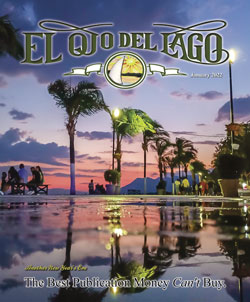BRIDGE BY THE LAKE
By Ken Masson
 When everyone at the table thinks they have a bid, the auction can get out of control in a hurry. That’s what happened when this deal was played at the Lake Chapala Duplicate Bridge Club in Riberas.
When everyone at the table thinks they have a bid, the auction can get out of control in a hurry. That’s what happened when this deal was played at the Lake Chapala Duplicate Bridge Club in Riberas.
West opened the bidding with a standard 1 club and North took advantage of the vulnerability to overcall 1 heart. East made a negative double showing spades and South, who was beginning to wonder just how many points there were in this deck, ventured 2 diamonds. West bid 2 spades to show he held 4 cards in that suit, North supported her partner’s diamonds and, not to be outdone, East (over)bid 3 spades. South couldn’t believe the auction to this point but thought “what the heck” and stunned all the other players by bidding 3 no trump.
West led a small spade and North looked rather sheepish as she put down her modest values. Somewhat to his surprise South could actually count 8 likely tricks: I spade, 1 club and, if they behaved, 6 diamonds. But where was the badly needed ninth trick to come from? It seemed to South that he would just have to take his lumps and accept defeat by one trick.
Then a funny thing happened on the way to perdition – declarer called for a small spade from the dummy on which East followed with the king! Now declarer could see the possibility of salvation: if the enemy’s spade honors were divided, then a low spade from the South hand towards dummy would turn the Jack into a winner. But due to a lack of entries, and the danger of squeezing the dummy, the play would have to be taken right away. When he led the spade 5, West hopped up with the queen and South was convinced he could hear the Hallelujah Chorus being sung in the distance.
West now cashed the ace and king of hearts but that was it for the defense – South could claim his contract. But, dear reader, do you see how East-West could have triumphed? It all depends on the card East chooses to play at trick one. A review of the bidding would show that West holds 4 spades, therefore South holds 2. One of them is surely the ace as declarer would not have a 3 no trump call without it. The only other consideration was what was the second card in the South hand? If it was the queen or the 10, it didn’t matter which card East played at trick one, declarer would always be entitled to two tricks in the suit. But if South’s second spade was lower than the 10, it was vital for East to put in the 9, restricting South to one trick in the suit and defeating the contract.
All bridge players know that third hand usually plays high but there is an addendum that is sometimes forgotten: only as high as necessary. When deciding how high a card to play, third hand must try to visualize the entire layout of the suit. Remember, the general idea is to try to keep Dummy’s high cards trapped whenever possible.
Amen.
Questions or comments: email: This email address is being protected from spambots. You need JavaScript enabled to view it.










